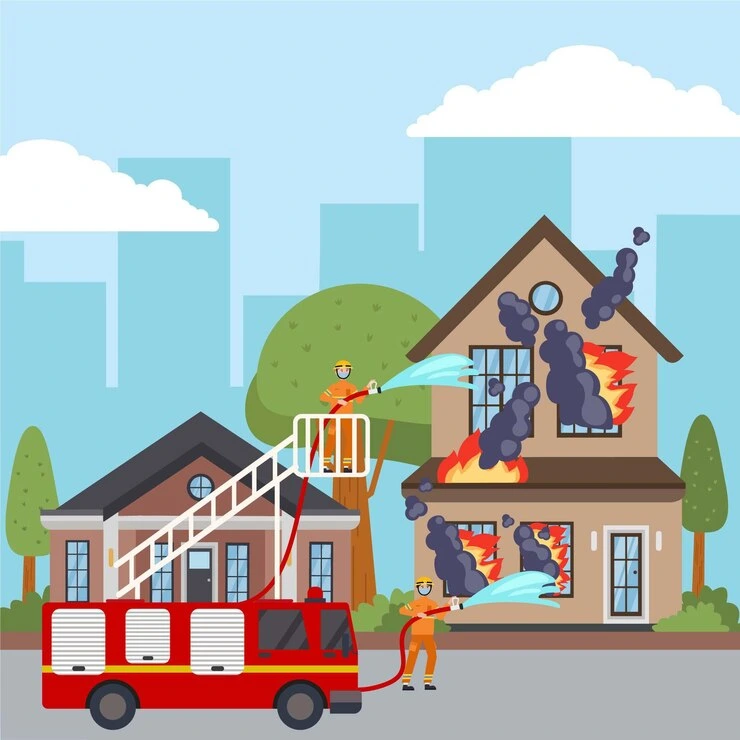House fires are one of the most alarming tragedies a landowner can encounter with. In just a few minutes, flames can make a home into losses, leaving behind damage, financial loss, and most of times even loss of life. However, the good update is that most house fires are avertible with the correct information and precautions.
This explanation will explain you over everything you require to recognize about house fire causes, deterrence strategies, emergency reactions, rescue steps, and key indicators. Either you’re a homeowner, tenant, or somebody viewing to advance fire safety, this explanation will arm you with the information required to keep yourself and your loved ones safe.
Knowing House Fire Causes
House fires can begin from multiple factors, but most fires shoot from just a trickle of origins. Identifying these dangers is the first step in dropping fire risks.
Common Culprits behind the Flames
Electrical mistakes are a major reason of house fires, adding for 27% of stated home fires. Defective wiring, old electrical schemes, and loaded discharges can all subsidies to fire hazards. Rottenly, wires destroy, and electrical apparatuses deteriorate, accumulating the probabilities of an electrical spark.
Employing too many high-powered devices on a single channel can burn the wiring behind walls. This often goes unobserved until a fire erupts. Emblems of electrical issues include flashing lights, repeated breaker tripping, or a burning odor near outlets. Homeowners should have their electrical systems examined every few years, particularly in older homes.
Alternate major cause-cause of house fires is smoking inside. Cigarettes, cigars, and other smoking materials cause fires when they are hastily castoff on furniture, carpets, or bedding. Falling asleep while smoking is particularly unsafe, as cinders can burn for hours before exploding into flames. Smoking outside and employing deep, robust ashtrays can significantly reduce this risk.
Kitchen Mishaps: The #1 Trigger
The kitchen is the most shared place where house fires begin, trending for nearly 49% of all housing fires. One of the prime hazards is lubricant fires. When cooking oil reaches its flashing point, it can catch fire within seconds, spreading flames rapidly. Trying to put out an oil fire with water is a deadly blunder—water sources the oil to splash and extend the fire even further.
As a substitute, a grease fire should be turn off by switching off the burner and casing the pan with a metal lid. Baking soda can also be employed to restrict small grease fires, but flour or sugar should never be utilized as they can provoke the flames. Placing a fire extinguisher in the kitchen and never exit cooking unattended are crucial safety measures.
Deterrence Strategies That Save Lives
Stopping fires before they occur is the best way to be safe. A few modest fire security procedures can considerably lower the risk of a house fire.
Smoke Alarms: Your First Line of Defense
Smoke detectors and fire alarms are one of the most effective fire deterrence applications, yet many homes either dearth them or have non-working components. Smoke and fire alarms should be fixed in every bedroom, lobby, and shared space to provide early precautions in case of a fire.
A working smoke detector and fire alarm can reduce the menace of death toll in a house fire by half. However, 23% of home fire mortalities happen in homes with smoke detectors and fire alarms that flop because of dead batteries. Testing alarms on monthly basis, swapping batteries annually, and substituting the entire unit every ten years can confirm they remain effective.
Childproofing Against Fire Hazards
Children are naturally inquisitive, and most of times that interest leads to unsafe fire-related situations. 43% of fire-related child damages arise due to the reason that children play with matches, lighters, or candles. Fire safety schooling should begin early, instructing children to stop playing with fire and what to do in case of an emergency.
Child-proofing the home can decrease fire risks. Employing stove knob covers prevents children from unintentionally making on burners, while fire-resistant pajamas provide an extra layer of protection during nighttime. Additionally, keeping flammable liquids, candles, and matches locked away can keep kids safe.
Emergency Response during a Fire
Even with the best deterrence strategies, fires can still happen. Knowing how to react can make the difference between life and death.
Evacuation Plans: Practice Makes Perfect
Each household should have a fire evacuation plan that sketches multiple paths to exit each room. Fire safety specialists endorse practicing fire workouts at least two times a year to keep everyone updated what to do in instance of an emergency.
When evading a fire, it is vital to stay calm. Smoke rises, so the freshest air is near the ground. Creeping on hands and knees can loan visibility and prevent inhalation of toxic smoke.
Having a chosen meeting spot outside ensures that everyone in the household is safe. It also prevents anyone from re-entering the fiery building to look for others, which is one of the most dangerous activities during a fire.
What to Do If Trapped
If evacuation routes are obstructed by fire or smolder, remaining in a closed room can enhance survival probabilities. Closing gates and sealing fissures with cloths or duct tape can avoid smoke from entering. Calling 911 and waving a flashlight or a piece of clothing out of a window can aid firefighters locate trapped individuals faster.

The Road to Rescue
Living a house fire is just the start. The rescue practice can be irresistible, but enchanting the correct steps can make transformation easier.
Dealing with Insurance Claims
Filing an insurance entitlement requires detailed certification. Homeowners should take snaps of the fire damage and gather a list of lost items along with their assessed costs. The Assurance Information Institute reports that 68% of entitlements resolve faster when policyholders deliver clear documentation.
Working closely with an insurance adjuster and knowing the details of the policy can aid homeowners obtain proper reparation for repairs and temporary arranged.
Rebuilding with Fire-Resistant Materials
When reconstructing after a fire, employing fire-resistant ingredients can bargain long-term security. Fire-resistant ceiling materials like metallic or asphalt gravels can decrease the spread of flames, while gypsum board walls repel fire double as long as wood walls. Additionally, fitting fire-rated doors and windows can provide extra protection in case of future fires.
Statistical Insights on House Fires
By the Numbers: Fire Facts
- A house fire can become lethal in just seven minutes.
- Annual U.S. fire damage costs exceed $12 billion.
- Three out of five fire-related deaths occur in homes without working smoke alarms.
Trends over Time
Fire incidents have decreased by 35% since 1980 due to advanced safety measures and building codes. However, the rise in wildfires now places over 60 million homes at risk, especially in regions prone to droughts and extreme heat.
Conclusion
House fires are destruction but largely avertible. Knowing the leading causes, applying fire safety approaches, and performing emergency exits plans, families can considerably reduce fire risks. Smoke detectors and fire alarms, fire-resistant resources, and consciousness of public dangers can protect breathes. Bearing ready today can mean the difference between life and death in an emergency.
FAQs about House Fires
Q: How do I stop a grease fire?
A: Cover the pan with a metal lid or use baking soda. Never use water or flour!
Q: Are older homes at higher risk for fires?
A: Yes, outdated electrical systems and old wiring significantly enhance fire risks.
Q: Can pets begin fires?
A: Yes. Pets have knocked over candles and make on stovetops. Employing safety guards can aid prevent accidents?
Q: How often should smoke alarms be replaced?
A: Every 10 years. Batteries should be tested every six months.
Q: What should I do if my clothes catch fire?
A: Stop, drop, and roll to smother the flames.
By staying informed and prepared, homeowners can keep their families and properties safe from fire hazards.














